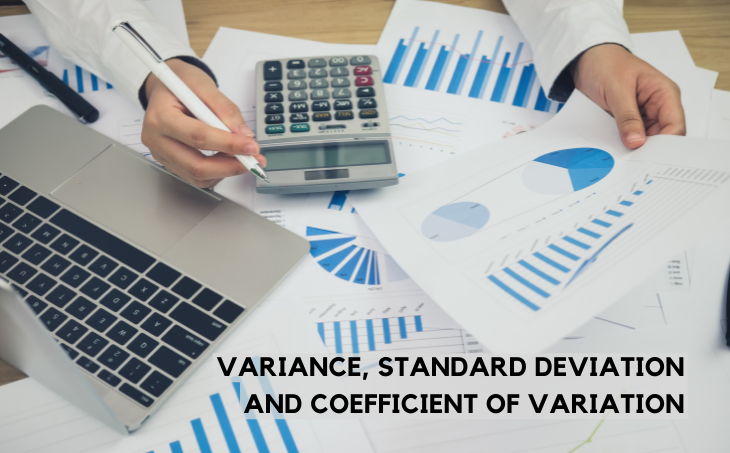
WHAT IS THE COEFFICIENT OF VARIATION?
The coefficient of variation refers to the statistical measure of the dispersion of data points around the mean. The coefficient of variation represents the ratio of the standard deviation to the mean. Also, to compare the degree deviation between different data series, the coefficient variation is a standard metric. It is a very efficient measure to compare the statistics of distinct data series.
COEFFICIENT OF VARIATION FORMULA:
In the domain of finance, the coefficient variation assists the investors to analyze the volatility and risks involved in comparison to the expected return on investment (ROI). It allows them to assess the risk-to-reward ratio before investing the money. Most of the time, investors look for security with a lower coefficient, as it provides the optimum risk-to-reward ratio with high returns and lower risks.
Mathematical Formula Of Coefficient Of Variation
Coefficient of Variation = (Standard Deviation/Mean)*100.
EXAMPLE OF COEFFICIENT OF VARIATION FOR SELECTING INVESTMENTS
There are many real-world examples of this. For example, someone is willing to invest and is considering different investment options for it. Let us discuss three different kinds of stocks
- Stock-1: Volatility of the shares is 20%, and ROI is 30%.
- Stock-2: Volatility of the stocks is 10%, and ROI is 22%.
- Stock-3: Volatility of the stocks is 40%, and ROI is 50%.
To find the best probable investment plan. The person did the following calculation
Coefficient Variation (Stock-1) = 20% ÷ 30% X 100% = 66.7%
Coefficient Variation (Stock-2) = 10% ÷ 22% X 100% = 45.4%
Coefficient Variation (Stock-3) = 40% ÷ 50% X 100% = 80.0%
Based on the calculation, the best option would be Stock-2, as it has the lowest coefficient of variation and optimum risk-to-reward ratio.
WHAT IS VARIANCE AND IT’S FORMULA
In statistics, Variance refers to the measurement of the extension between numbers in a data set. This means that it measures how far each number in a particular set is from the average
The mathematical representation of variance is:
xi=Value of the ith point in the data set
x=The average value of the data set
n=The total number of data points in the data set.
WHAT IS STANDARD DEVIATION AND ITS FORMULA
Standard deviation calculates or measures the dispersion of data set relative to the mean.
It is calculated as the square root of the variance; more the dataset spread out, the higher the standard deviation.
Standard deviation is essential in the finance domain. It shows the past volatility of an investment when applied to the rate of return of investment. The higher the standard deviation of security is, the variance equally becomes higher between each price and the mean.
The mathematical representation of the standard deviation is this:
where:
xi=Value of the ith point in the data set
x=The average value of the data set
n=The total number of data points in the data set.
How to Calculate and Interpret the Coefficient of Variation in Investment Analysis:
Coefficient of Variation (CV) is an important measure of statistics that can be utilized to determine the risk at a unit level of returns in investments. To calculate it, simply divide an investment’s standard deviation (risk) by its expected return (mean). As an example, suppose that Stock A has a standard deviation of 10 percent and an expected return level of 15 percent, then the CV will be 0.67. The lower the CV, the more advantageous the risk adjusted return is and that is why it is a vital instrument in achieving the comparison of various investments, whether an individual stock or a portfolio in general. Understanding of CV assists investors in making better decisions by showing which goods are providing greater returns as compared to the risk being taken thereby leading to more effective division of funds.
These insights are often emphasized in comprehensive financial and investment training programs Singapore, and are essential for learners in any practical investment course for beginners in Singapore aiming to master risk-adjusted performance evaluation.
Coefficient of Variation vs. Standard Deviation: When to Use Which in Finance:
Although the volatility is measured in Standard Deviation (SD) and Coefficient of Variation (CV), there is a great difference in usage in the field of finance. Stand Deviation is used to quantify absolute or variance of data points; hence it is suitable in comparing the assets, which are expected to have the same returns. To illustrate, in comparing these two bonds having similar yield, SD basically indicates which bond is riskier, though it does not explicitly show what the level of risk is. The Coefficient of Variation on the other hand, quantifies relative dispersion, stating the risk to unit-of-return. This renders CV essential when comparing investments with extremely different anticipated returns, e.g. very low-growth utility share versus high-growth tech stock, giving a better idea as to the relative attractiveness of an investment on a risk-adjusted basis. These analytical techniques are frequently taught in the best finance certification courses in Singapore for professionals and are foundational components of any advanced financial modeling course in Singapore, especially for those seeking to make sound, data-driven investment decisions.


